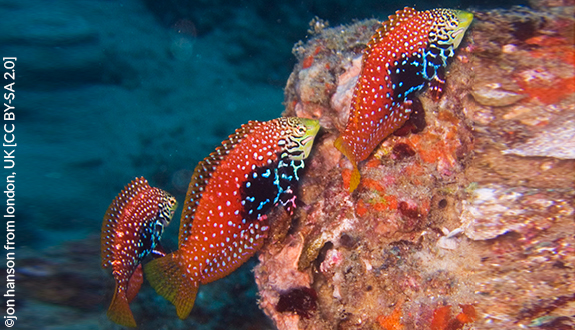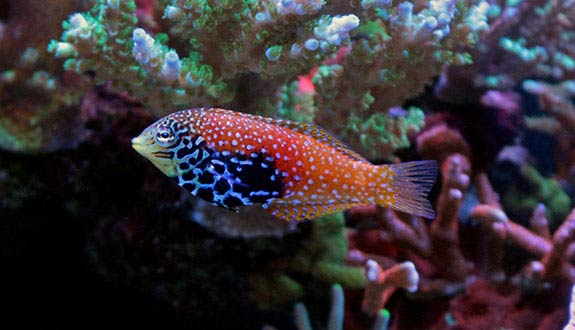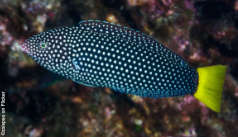

Alternative species (click on the thumbnail to see the card)
Names
Scientific name
Macropharyngodon bipartitus
Macropharyngodon bipartitus bipartitus
Macropharyngodon varialvus
Common name
Blue Star Leopard Wrasse
Splendid Leopard Wrasse
Rare wrasse
Vermiculate wrasse
Origin

Origin: Indian Ocean
Natural habitat: Up to 25 m deep, it lives in coral reefs and rocky areas
Dimorphism

Males have green patterns and their coat is strongly orange while females have blue spots and black lower body.
Group

Labridae
Volume

200 L / 44 Imp gal / 53 US gal
Parameters

T°: 24 à 28°C or 75 to 82°F
pH: 7.5 to 8.5
Density: 1021 to 1026
Difficulty

Easy
Size

10 to 13cm (4 to 5.1")
Longevity

6 to 7 years
Living zone

Depth
Individuals

3 (harem)
Food
How to feed the Blue Star Leopard Wrasse?
Food
How to feed the Blue Star Leopard Wrasse?
The worm-eaten whipworm is carnivorous. Offer it artemia, krill, mysis, mussel or fish flesh and occasionally mud worms. For good health, it is imperative to feed it enough and vary its meals as much as possible to avoid deficiencies.
Behavior
What kind of behavior does the Palette Blue Star Leopard Wrasse have?
Behavior
What kind of behavior does the Blue Star Leopard Wrasse have?
This labradoodle has good social skills on the whole. There is a slight aggressiveness towards its fellow creatures.
It is generally active and spends most of its time foraging. To do so, it quietly paces around the landscape. It is peaceful and has a good character.
To sleep, it buries itself in the sand. He can also resort to this solution in case of danger. Moreover, he lives mainly in the lower part of the aquarium. It sometimes searches the substrate in search of small prey.
Cohabitation
Who can live with the Blue Star Leopard Wrasse?
Cohabitation
Who can live with the Blue Star Leopard Wrasse?
The males of this species cannot tolerate the presence of rivals on the territory. Only one male per aquarium will be kept. As for the females, you can put two with the male. The dominant will be the bigger of the two.
He is very respectful of corals and will not degrade them. The only exception will be for the tubeworms which he eats greedily. Avoid them!
Lively or aggressive fish can harm this fish. It may decide to escape such roommates by jumping out of the aquarium.
Breeding
How to breed the Blue Star Leopard Wrasse?
Breeding
How to breed the Blue Star Leopard Wrasse?
Impossible in captivity.
Interesting fact: all the fry are female. It's only as they grow that some will turn into males. Living in a trio (the male and his two females), the larger female is the dominant one. If the male dies, she is likely to turn into a male!

Its aquarium
Which aquarium for the Blue Star Leopard Wrasse?
Its aquarium
Which aquarium for the Blue Star Leopard Wrasse?
The ideal habitat will consist of numerous rocks, algae and invertebrates. You've no doubt guessed that these are the basic elements of a reef aquarium!
Arrange your rocks so that they form corridors and crevices that allow the fish to move around out of sight. There should also be plenty of hiding places. Put a good layer of sand in your aquarium so that the plow can burrow in.
The water quality is sensitive enough, so keep nitrate levels as low as possible. To do this, plan for good filtration and regular water changes.
Finally, cover your aquarium because it can jump out of the water. However, this behaviour is not normal: it is a symptom of something wrong, usually a roommate who is a little too agitated…
Good To know
Find all additional information!
Good To know
Find all additional information!
Like most Macropharyngodon, this species is quite difficult to acclimatize. After this tricky time, the worm-eaten wrasse is a robust and tough fish.
Males can be distinguished from juveniles and females by their different coloration. They have green patterns while females have blue dots and the lower body is black.
Yours photos!
Comments
Sort by:
Please login to post comments


